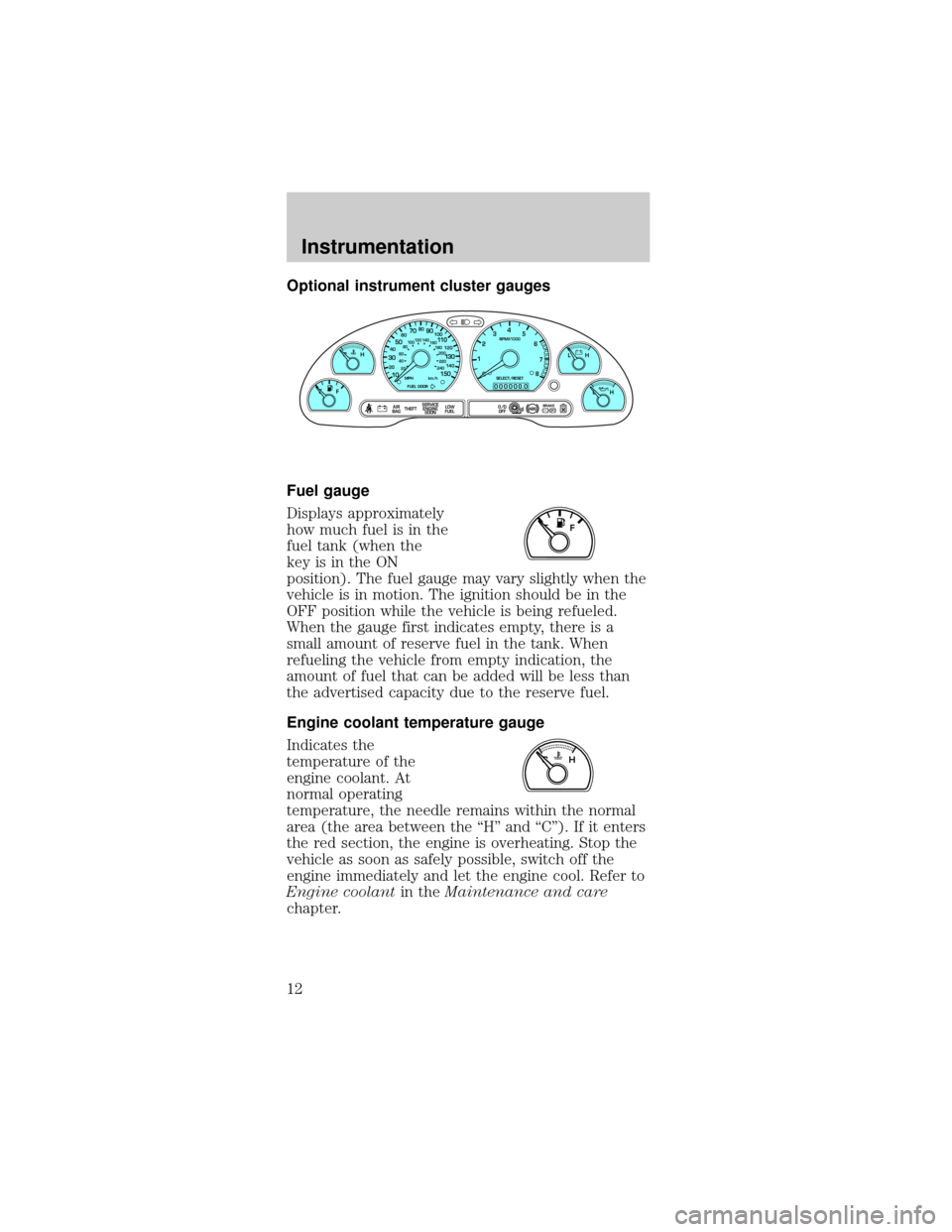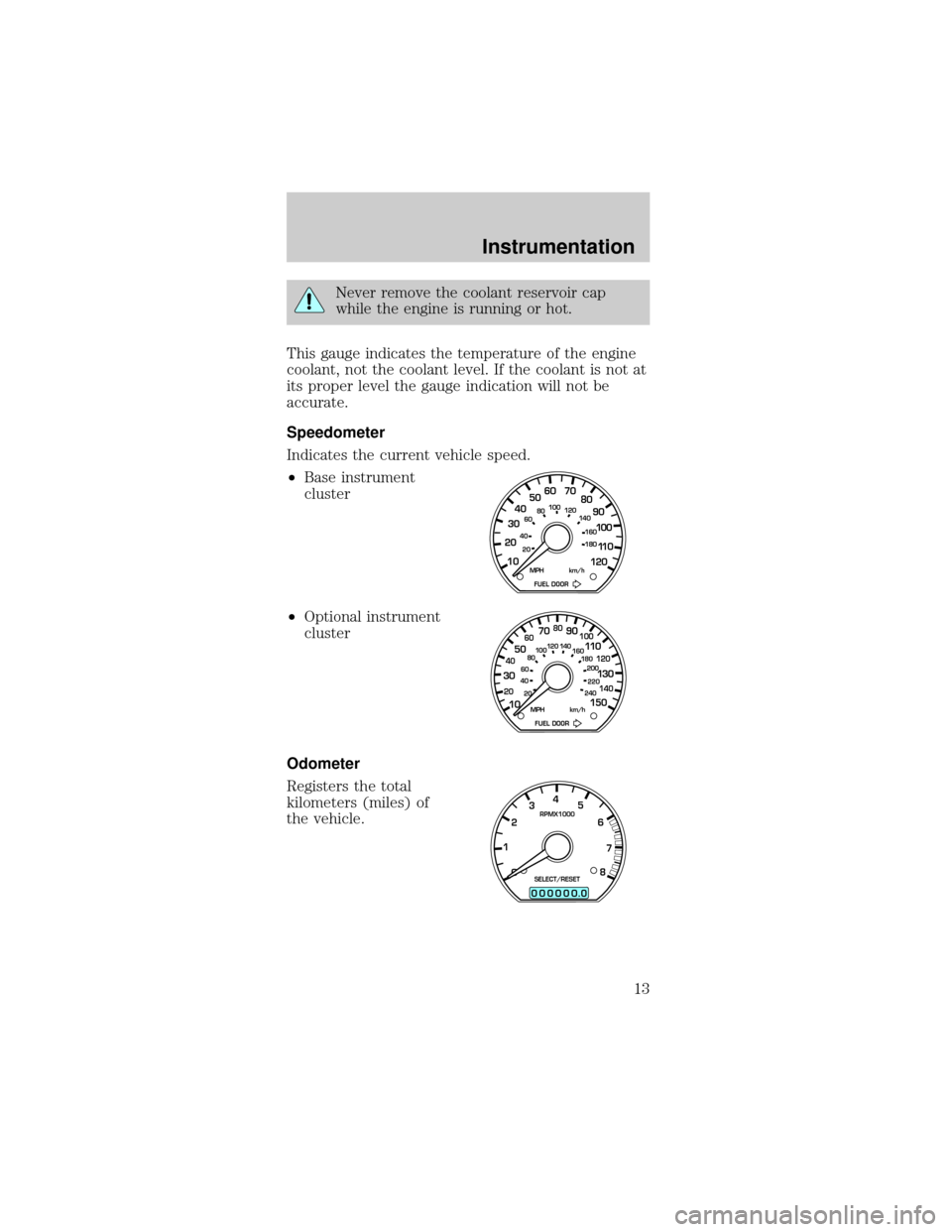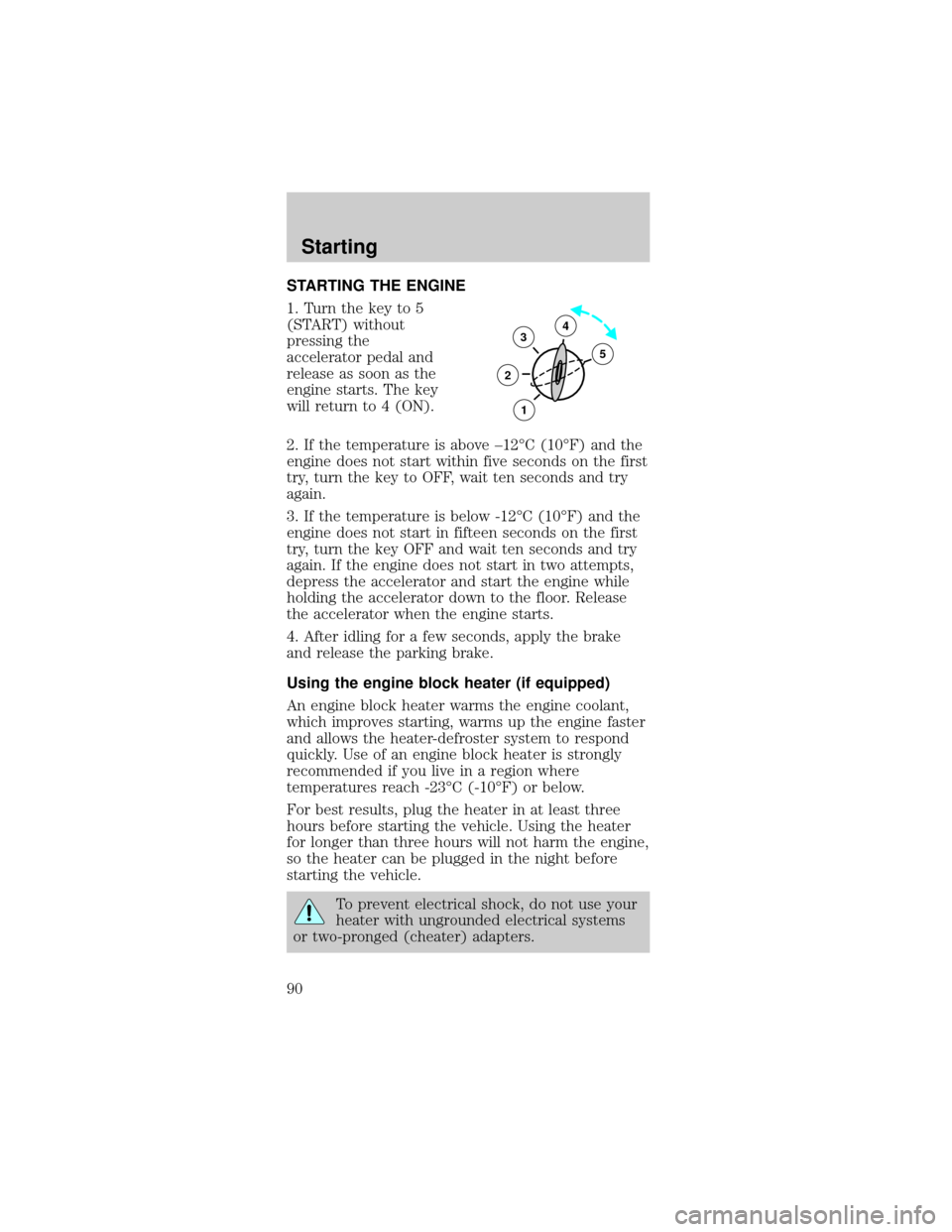coolant temperature FORD MUSTANG 1999 4.G Owners Manual
[x] Cancel search | Manufacturer: FORD, Model Year: 1999, Model line: MUSTANG, Model: FORD MUSTANG 1999 4.GPages: 216, PDF Size: 1.72 MB
Page 12 of 216

Optional instrument cluster gauges
Fuel gauge
Displays approximately
how much fuel is in the
fuel tank (when the
key is in the ON
position). The fuel gauge may vary slightly when the
vehicle is in motion. The ignition should be in the
OFF position while the vehicle is being refueled.
When the gauge first indicates empty, there is a
small amount of reserve fuel in the tank. When
refueling the vehicle from empty indication, the
amount of fuel that can be added will be less than
the advertised capacity due to the reserve fuel.
Engine coolant temperature gauge
Indicates the
temperature of the
engine coolant. At
normal operating
temperature, the needle remains within the normal
area (the area between the ªHº and ªCº). If it enters
the red section, the engine is overheating. Stop the
vehicle as soon as safely possible, switch off the
engine immediately and let the engine cool. Refer to
Engine coolantin theMaintenance and care
chapter.
P! BRAKE
0
00000 00
FH
H
102040608020 40608010 012 0 14 0
160
180
200
220
240
100
120
140
305070 90
110
13 0
1504
5
6
7
8 3
2
1
H
THEFT
RPMX1000
FUEL DOORSELECT/RESET
LOW
FUELO/D
OFF AIR
BAGSERVICE
ENGINE
SOON
MPH km/h
ABS
.
L
L
F
CH
Instrumentation
12
Page 13 of 216

Never remove the coolant reservoir cap
while the engine is running or hot.
This gauge indicates the temperature of the engine
coolant, not the coolant level. If the coolant is not at
its proper level the gauge indication will not be
accurate.
Speedometer
Indicates the current vehicle speed.
²Base instrument
cluster
²Optional instrument
cluster
Odometer
Registers the total
kilometers (miles) of
the vehicle.
10 203020 406080100
120
140
160
180
405060 70
80
90
100
11 0
120
FUEL DOOR MPH km/h
102040608020 40608010 012 0 14 0
160
180
200
220
240
100
120
140
305070 90
110
13 0
150
FUEL DOOR MPH km/h
0
00000 00
4
5
6
7
8 3
2
1RPMX1000
SELECT/RESET
.
Instrumentation
13
Page 90 of 216

STARTING THE ENGINE
1. Turn the key to 5
(START) without
pressing the
accelerator pedal and
release as soon as the
engine starts. The key
will return to 4 (ON).
2. If the temperature is above ±12ÉC (10ÉF) and the
engine does not start within five seconds on the first
try, turn the key to OFF, wait ten seconds and try
again.
3. If the temperature is below -12ÉC (10ÉF) and the
engine does not start in fifteen seconds on the first
try, turn the key OFF and wait ten seconds and try
again. If the engine does not start in two attempts,
depress the accelerator and start the engine while
holding the accelerator down to the floor. Release
the accelerator when the engine starts.
4. After idling for a few seconds, apply the brake
and release the parking brake.
Using the engine block heater (if equipped)
An engine block heater warms the engine coolant,
which improves starting, warms up the engine faster
and allows the heater-defroster system to respond
quickly. Use of an engine block heater is strongly
recommended if you live in a region where
temperatures reach -23ÉC (-10ÉF) or below.
For best results, plug the heater in at least three
hours before starting the vehicle. Using the heater
for longer than three hours will not harm the engine,
so the heater can be plugged in the night before
starting the vehicle.
To prevent electrical shock, do not use your
heater with ungrounded electrical systems
or two-pronged (cheater) adapters.
3
2
1
5
4
Starting
90
Page 144 of 216

Always dispose of used automotive fluids in a
responsible manner. Follow your community's
regulations and standards for recycling and disposing
of automotive fluids.
Coolant refill capacity
To find out how much fluid your vehicle's cooling
system can hold, refer toRefill capacitiesin the
Capacities and specificationschapter.
Have your dealer check the engine cooling system
for leaks if you have to add more than 1.0 liter (1.0
quart) of engine coolant per month.
Severe winter climate
If you drive in extremely cold climates (less than
±36ÉC [±34ÉF]), it may be necessary to increase the
coolant concentration above 50%. Refer to the chart
on the coolant container to ensure the coolant
concentration in your vehicle is such that the
coolant will not freeze at the temperature level in
which you drive during winter months. Never
increase the coolant concentration above 60%.
Increased engine coolant concentrations above 60%
will decrease the freeze protection characteristics of
the engine coolant. Vehicles driven year-round in
non-extreme climates should use a 50/50 mixture of
engine coolant and distilled water for optimum
freeze protection.
CHECKING AND ADDING POWER STEERING
FLUID
Check the power steering fluid. Refer to the
Scheduled Maintenance Guide for the service
interval schedules. If adding fluid is necessary, use
only MERCONtAT F.
Maintenance and care
144
Page 145 of 216

If your vehicle is
equipped with the
3.8L V6 engine,check
the power steering
fluid level with the
engine at normal
operating temperature.
1. Start the engine and
let it run until it
reaches normal
operating temperature
(the engine coolant
temperature gauge
indicator will be near
the center of the
normal area between H
and C).
2. While the engine idles, turn the steering wheel
left and right several times.
3. Turn the engine off.
4. Check the fluid level on the dipstick. It should be
within the FULL HOT range. Do not add fluid if the
level is within this range.
5. If the fluid is low, add fluid in small amounts,
continuously checking the level until it reaches the
correct operating range. Be sure to put the cap back
on the reservoir.
FILL
HOT
Maintenance and care
145
Page 209 of 216

Fluid capacities ....... 183
Foglamps ................... 53
Fuel .......................... 158
calculating fuel
economy ................ 164
cap ......................... 161
capacity ................. 183
choosing
the right fuel ......... 162
comparisons with
EPA fuel economy
estimates ............... 168
detergent in fuel ... 163
filling your vehicle
with fuel .. 158,161,164
filter,
specifications . 163,182
fuel pump shut-off
switch .................... 112
gauge ....................... 12
improving fuel
economy ................ 164
low fuel
warning light ............. 9
octane rating .. 162,188
quality .................... 162
running
out of fuel ............. 163
safety information
relating to
automotive fuels ... 158
Fuses ................. 113,114
Gas cap
(see Fuel cap) ......... 161
Gas mileage(see
Fuel economy) ........ 164
Gauges .................. 11,12
battery voltage
gauge ....................... 15
engine coolant
temperature gauge . 12engine oil pressure
gauge ....................... 15
fuel gauge ................ 12
odometer ................. 13
speedometer ........... 13
tachometer .............. 14
trip odometer .......... 14
GAWR (Gross Axle
Weight Rating) ........ 106
definition ............... 106
driving with
a heavy load .......... 106
location .................. 106
GVWR (Gross Vehicle
Weight Rating) ........ 106
calculating ............. 106
definition ............... 106
driving with
a heavy load .......... 106
location .................. 106
Hazard flashers ....... 112
Head restraints ......... 64
Headlamps ................. 16
aiming ............. 175,176
bulb
specifications ........ 175
daytime
running lights .......... 16
flash to pass ............ 45
high beam ............ 7,45
turning on and off .. 16
warning chime ........ 11
Heating ...................... 18
heating and air
conditioning
system ..................... 18
Hood ........................ 132
Ignition ..................... 188
positions of the
ignition .................... 45
removing the key .. 105
Index
209